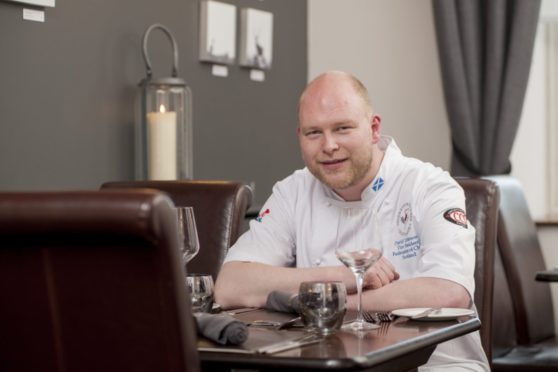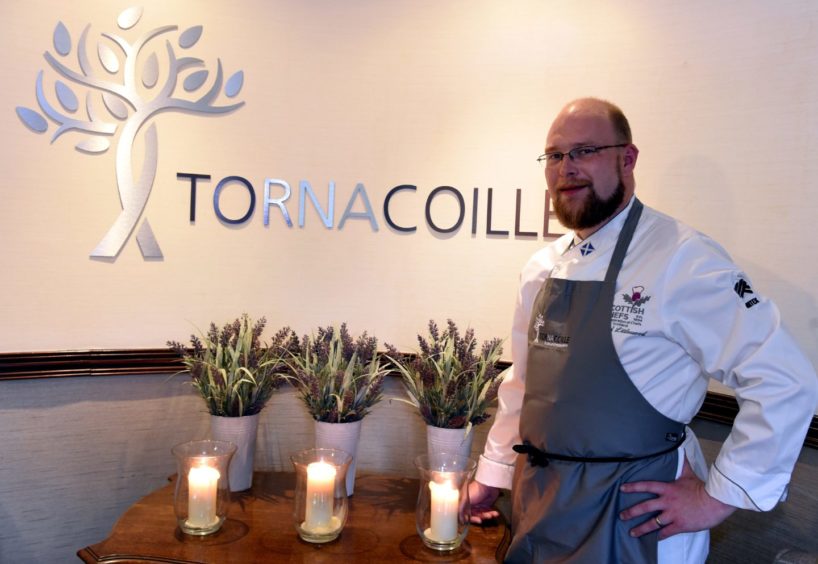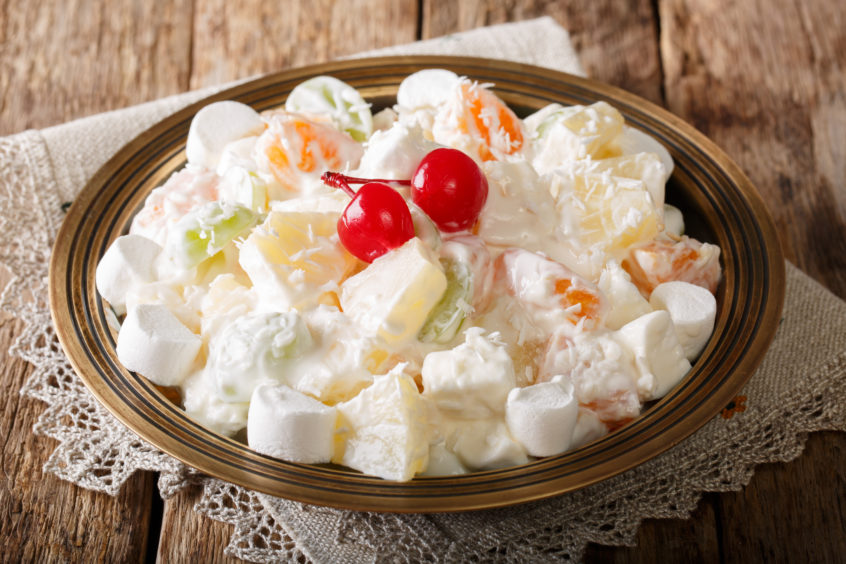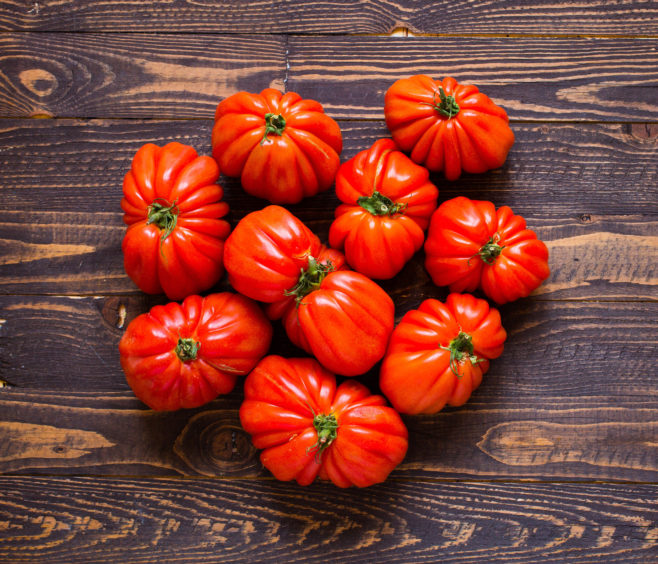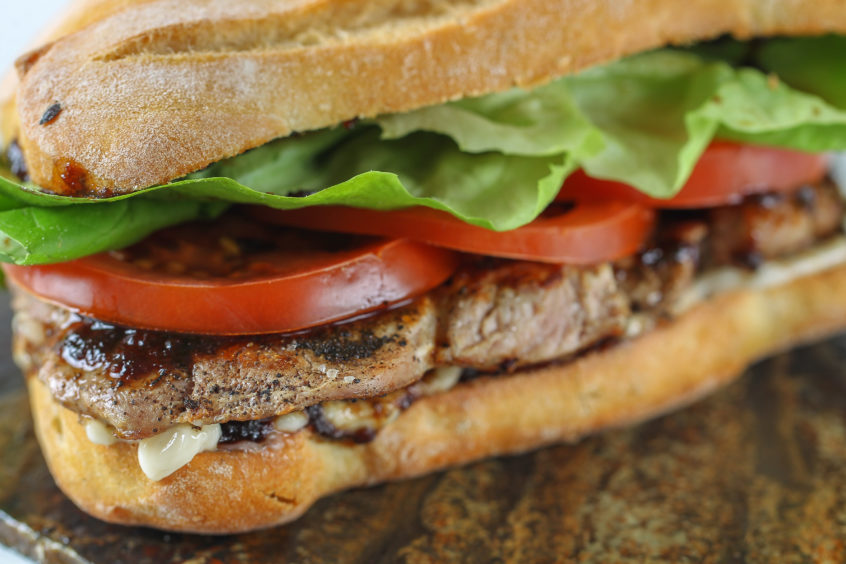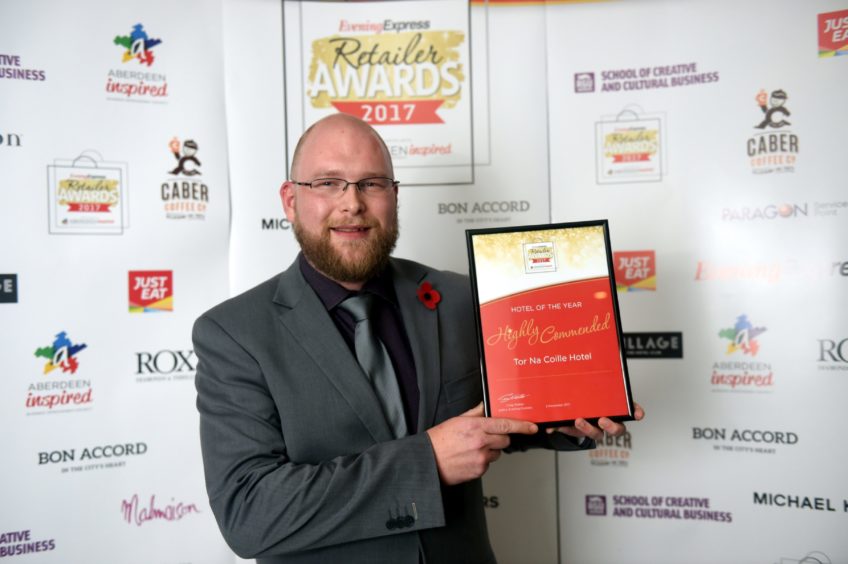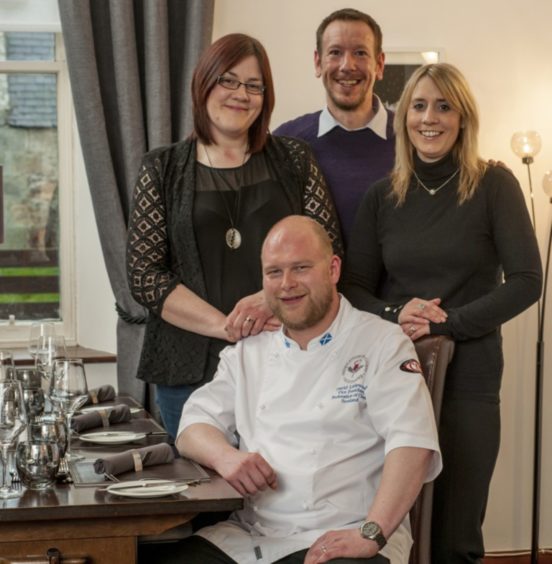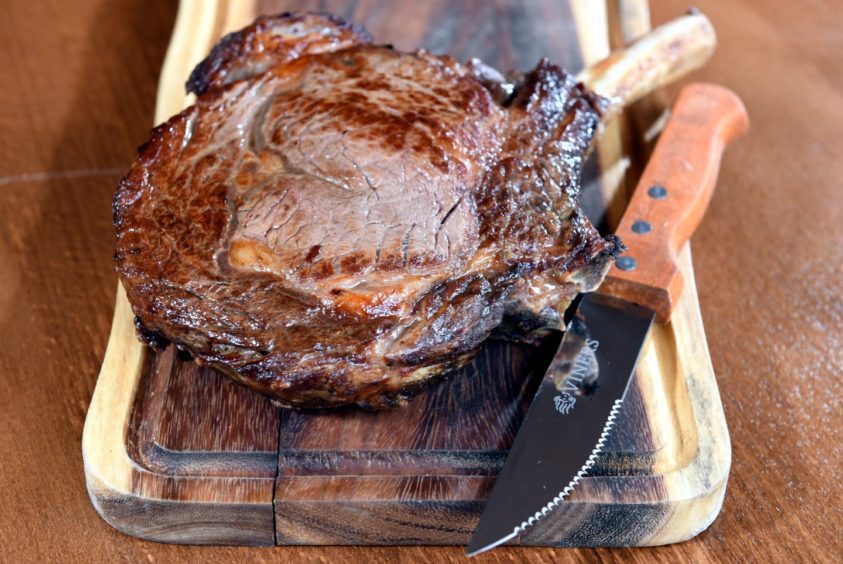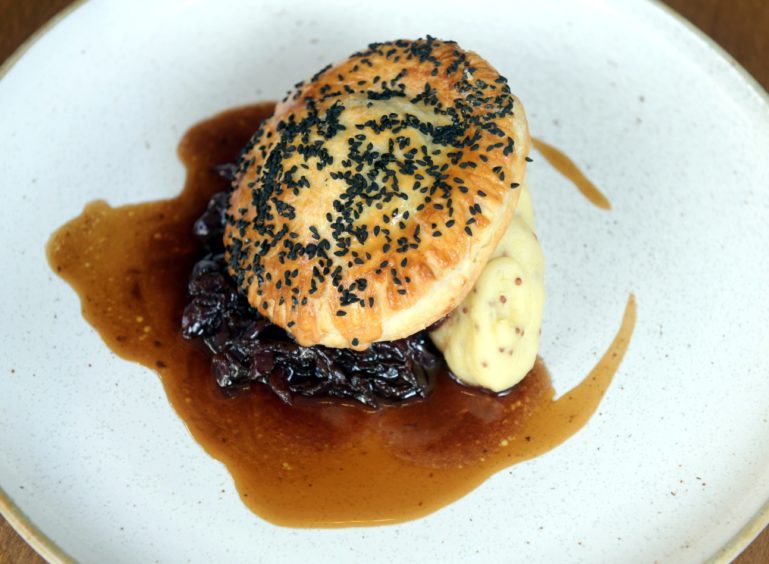In this weekly series, Rebecca Shearer speaks to those who have helped shape Scotland’s food and drink industry, and finds out more about the role that fine fare has played throughout their life and career…
From a childhood growing up in hotels, to spending his summers on a boat in Italy, to becoming one of the country’s most prominent chefs, David Littlewood really knows his onions.
At 37, he already has titles to the likes of Scottish Chef of the Year 2013-14, Grampian Young Chef of the Year, Grampian Chef of the Year, Master Chef of Great Britain and the SHA Awards Medaille d’Or, as well as becoming the youngest ever president of the Federation of Chefs Scotland in 2017.
He now runs Tor Na Coille in Banchory and the Kildrummy Inn near Alford with his brother-in-law Nigel Hake, and was a regular columnist for the Press and Journal’s weekly food magazine, The Menu.
Childhood – Marshmallow Surprise
Growing up with parents who work in the hotel trade meant that David and his siblings were exposed to a lot of good food when they were younger.
“I grew up in and around the north east of Scotland,” he said.
“My parents owned a hotel in New Deer then took on the Mosset Tavern in Forres, then moved back to New Deer and bought back the original hotel, then left the trade after that. That’s when I was about 11.
“So, from a young age we were exposed to a wide variety of food – from home-cooked meals to restaurant quality stuff as well. But if I had to choose something that sticks out from back then, it wouldn’t be one of the fancy dishes or some of the food from around the world we tried as kids.
“Mum always made this one thing called marshmallow surprise. It was the simplest dish you could ever imagine! Whenever we were having dinner at home, everyone would ask her to make it. She used to make it for us as kids to keep us out of her way so she could get on with cooking the food for the main meal.
“This would consist of marshmallows, cut up into pieces, mixed with double cream and tinned fruit cocktail. The marshmallows would absorb, like a sponge, the cream and become like a mousse.
“Mum would have us sit at the table with a pair of scissors and a cup of water – and the trick is if you dip the scissors into the cup of water then it means the marshmallows don’t stick to them. We’d have to cut the marshmallows up into small pieces and get through bags and bags of them, enough to fill a small trifle bowl. It would keep us sitting there for ages.
“And there’d always be a fight over who got the one cherry that these tins of fruit cocktail always seemed to come with. Me, my brother and my little sister would always fight over who got the one cherry. But it would never make it to the marshmallow surprise – it would always be eaten before.
“I was one of five kids but my older brother and sister were quite a bit older so they’d be working in the hotel as well. They’d eat the marshmallow surprise, but wouldn’t make it! I think we’ve all made it with our own kids now as well.”
Teens – Tomatoes
A trip to Italy in his teens also helped ignite David’s passion for food, though he wasn’t to realise this until many years later.
“I think my teens were a pivotal point in terms of my own ideas about food. My mum, before she met my dad, spent some time in Italy and lived over there for a brief spell, and she always spoke about it – there was a real Italian influence in her food.
“When I was 15, her friends in Italy invited me over for a holiday. They had a boat they would take out for six to seven weeks every summer – it was a sailing yacht – and they would sail from the north-east coast, down across the Mediterranean, and then down one side of Corsica, into Sardinia, then back up the other side and back home again. For two summers I was invited to join them.
“Bianca, my mum’s friend, was a fantastic cook. It was very traditional and although I’d had quite a good upbringing with regards to being able to try different things, when I was a kid I’d decided I didn’t like tomatoes. For lunch on the boat we would have a bowl of tomatoes. They weren’t the kind we get over here – they were huge (about the size of a tennis ball) and bought every day from the markets at the various ports we visited.
“Then they were prepared every day in the same way – peeled by hand, then cut up into large chunks, with a good glug of a really good-quality fresh olive oil, a few cloves of bashed garlic – it wasn’t chopped. All into the bowl and a few leaves of torn basil, with some black pepper and salt.
“We’d have loaves of bread that would get eaten up really quickly and were so good at mopping up the juices. That’s when I developed this love of fresh tomatoes, which I thought I didn’t like. That trip opened my eyes to the idea of taking something as simple as can be and making it into something quite delicious.
“That’s developed a lot of my thinking towards food today. If you’ve got a fantastic quality product – you don’t really need to do much to make it very good to eat.”
20s – Steak Sandwich
Before training as a chef, David started studying law at university, while also working almost full-time hours in restaurant kitchens, to help him secure the funds he needed.
“Trying to balance nearly full-time hours with a law degree and a little bit too much of the social aspect was difficult and I probably felt I wasn’t doing as well as I should’ve done,” he said.
“So I took a year out and applied for a job with a chef called Brian Mutch who’d just been employed to oversee the fine dining restaurant at Miami Beach (based at Aberdeen’s Codona’s) when they’d built that.
“That’s when I started learning how to cook properly – how to make a stock and reduce it down to make a jus and how to butcher whole animals. Brian would explain every muscle and how to separate them all out, which ones would be tough and which ones wouldn’t. I was absolutely in awe of this and found that I was actually happier in the kitchen than I had been in the lecture theatre.
After working as a commis chef under Brian for a few months, he then encouraged David to enter the North East Young Chef of the Year competition in 2002.
“I won it, unexpectedly, and part of the prize was to spend a week’s work experience working with Kevin MacGillivray, who’s a Masterchef of Great Britain, down at Ballathie House Hotel in Perthshire when he was head chef there,” David said.
“So I went for this week with Kevin then a few months afterwards he phoned me up and said someone had left and that a position had become available, would I like to take it? So I took the opportunity and I went to work there.
“The menu would change every day so it was a fantastic learning opportunity for a chef because you were learning something new every single day, with new ingredients and dishes.
“The thing that sticks out in my mind is learning how to cook meat properly, including steak. We’d use the best quality beef there and because it was a high value item, if you messed one up then you really knew about it.
“Learning how to cook a steak properly was so important. It had to be done by feel and just knowing somehow, the right points to bring it off, slow it down and to rest it.
“On a Saturday night at Ballathie it was really busy and we’d do long shifts. But Kevin would go home after dinner or he’d go into his office and write the menu for the next day and then he’d leave while were still cleaning the kitchen. There was four of us that would stay back, though we all lived at Ballathie House as it is in the middle of nowhere. We were so busy as well so we wouldn’t really get a chance to eat at staff mealtimes.
“He’ll probably kill me if he reads this but we used to take the end bit off a filet or take a bit of steak – just one – and it would become the centre of our lives for about an hour. Each of us would do our own bit and we’d make a steak sandwich to share between the four of us.
“I was the pastry chef so I would’ve made bread during the day and we’d usually have some bits left so we’d use it to make the steak sandwich. One of the guys would make a fresh Dijon mustard mayonnaise, the veg guy would go and get some crisp cos lettuce and some sliced tomatoes and caramelise some onions. We’d carve this one steak up to do the four of us and always had a fried egg in it as well. It’s one of those things that just sticks in my mind.
“Of course we’d have to be sly about it, as there were other staff going about that would have pasta or leftovers from breakfast for their supper, but we were having this glorious steak sandwich.”
30s – Cheap cuts of meat, venison shank
In his 30s David opened his first restaurant, the Kildrummy Inn near Alford, along with his brother-in-law, Nigel Hake, and their wives – Sophie and Helen, who are sisters.
“It was a country pub which was not very well known other than among the locals. The days of the country pubs are over with the drink driving laws changing a few years back etc, so we had to develop it.
“When we went to have a look at it, the previous owners were moving to Australia, it was a very traditional country pub doing traditional pub food. We sought to change the business and make it more into a restaurant with rooms. We had no investors other than a small loan from the bank and we’d cleaned out every last penny from down the back of the sofa to put into the business, we didn’t have a lot of money for staff and we were technically building it from scratch.
“So originally it was just myself in the kitchen and Nigel, my brother-in-law, front of house while our wives still worked. We wanted to create a fine-dining style restaurant but there was only me there having to do the starters, the intermediates, the mains, the desserts.
“Firstly we had to win the locals over, as we had taken over their only country pub. As it is an agricultural area, they’re quite used to big portions and hearty food so we had to ask ourselves what they’d enjoy and what would keep the costs down for us. So looking at the slow braising, cheaper cuts of meat was one of the main things that we did and still influences my cooking today.
“The prime cuts – a piece of fillet, a piece of loin, for example – are very easy to cook, generally speaking, for a chef. It’s just a case of cooking it quite quickly and keeping your timings accurate. And with things like water baths that we use nowadays, it’s almost impossible to go wrong. But cheap cuts, like a pig’s cheek or braised shank of venison or lamb, are the things that really excited me – and still do.
“I’m charging less now for a four-course dinner than we charged at Ballathie almost 20 years ago, but the cost of everything since then has gone up so the margins become slimmer and you have to now think about keeping the actual cost of the food down. So utilising cheaper cuts that have been slow cooked, and to create something delicious out of it is a fantastic way of utilising the whole part of the animal.
“When dealing with local producers, they’re selling a lot of their prime cuts at markets at retail cost, which you can’t afford to pay as a restaurateur. You need to buy it at a wholesale price so that you can still make a margin on it. But because people are buying the prime cuts it means these farmers are left with the shanks etc which people aren’t as confident about cooking, so you can utilise them as a chef and get very good quality product at a reasonable price.
“Pig’s cheek is a fantastic thing or a venison shank. As a chef, when you spend the entire week working in a kitchen and doing all the extra flourishes that come with presenting a dish well, when you’re home on your day off all you really want to eat is a hearty meal with some good meat. A venison shank is often good for this with some mashed potatoes. It’s just exactly what you crave.”
Now – Barbecue
“As we’re in lockdown just now this is the most amount of time I’ve spent with my children in any one period of time since they were born. My son is 14 and my daughter is nearly 11 and when they were younger I was leaving for work before they got up and coming home after they’d gone to bed. Sometimes that would be for six or seven days a week so I missed out on most of their childhood.
“So I’ve been doing all the cooking for them at home and have been doing a lot of barbecuing. The other day I got up at four in the morning to put a brisket on the barbecue and cooked it for 16 hours on the smoker and I’ve got some pastrami curing in the fridge that I am going to smoke later in the week. I’ve just been playing about with things like that these past few weeks.”
Braised Venison Pithivier
(Serves 2)
Ingredients:
- 400g venison shoulder, diced
- 500ml game or chicken stock
- 150ml good red wine
- 2 cloves garlic, chopped
- 1 carrot, diced
- 1 small onion, diced
- 1 tsp redcurrant jelly
- 2 sprigs thyme
- 2 juniper berries, finely chopped
- Puff pastry (I just use the pre-rolled stuff at home for ease)
- Egg wash
- Black onion seeds or sesame seeds (optional)
Method:
- In a large, hot saucepan, sear and colour the venison, then remove from the pan.
- In the same pan, heat a little oil and sweat the onion, garlic, carrot, thyme and juniper.
- Add the venison back in, along with the wine, stock and jelly. Bring to the boil and remove from the heat.
- Cover with a tightly-fitting lid and place in the oven at 150°C for 1½ – 2 hours, or until the meat is tender.
- Remove most of the liquid and reduce in a separate pan (cover the meat to avoid it drying out). Once the liquid is reduced and thickened, slightly flake up the meat and mix it in.
- Allow to cool completely.
- Once the meat filling is cold, cut four large discs from the puff pastry, using a saucer as a template. Place a large spoonful of the venison filling on one disc, and cover it with a second, enclosing the meat.
- Press all the way around the edge with a floured fork. Brush the egg wash and sprinkle the onion seeds (or sesame seeds if you prefer).
- Chill for 20 minutes in the fridge, then bake at 180°C for 25-30 minutes or until the pastry is light, golden and crisp.
- Serve with some braised red cabbage and grain mustard mash for a hearty main course, or eat them on their own like a pasty.
Read more from this series
